The Geekom IT15 AI is a Core Ultra 2 mini PC that's both small and mighty
The up-to-date Core Ultra 9 285H CPU gives Geekom's new IT15 impressive levels of performance
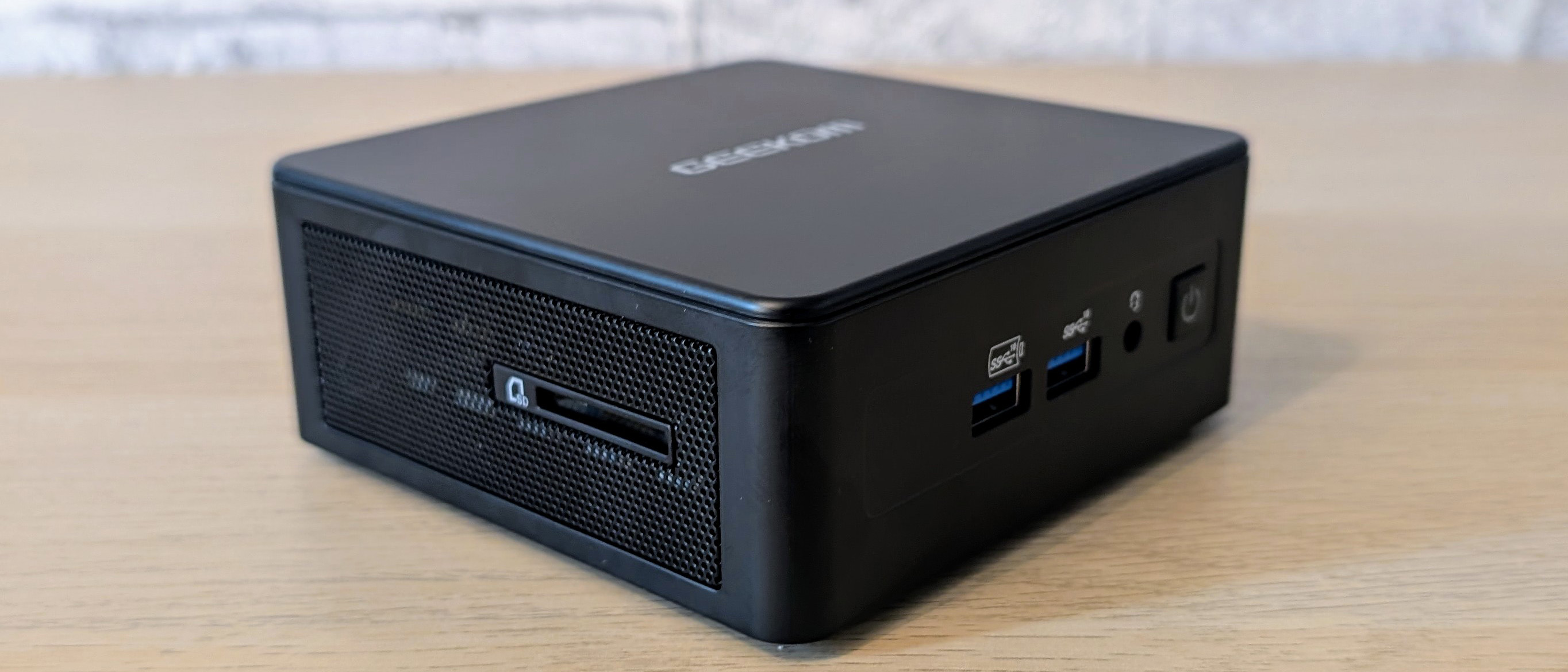
-
+
Powerful chipset
-
+
Wi-Fi 7 connectivty
-
+
Good selection of I/O ports
-
+
Easy to increase memory and storage
-
+
Can be powered via DC-in or USB-C PD
-
-
Thermal throttling is evident under stress
-
-
DisplayPort graphics only via USB-C
-
-
Limited NPU

It has taken a good six months for the first Core Ultra Series 2 mini PC boxes to arrive, with a new model just launched and sent to us for review by Geekom – the Geekmom IT15 AI. Have Arrow Lake mini PC's been worth the wait? Are they worth the extra cost over their roughly equivalent Meteor Lake brethren?
At the time of writing, the Geekmom IT15 AI is available via Amazon in two flavours, both packing 32GB of RAM. One features the Core Ultra 5 225H CPU with a 1TB SSD and costs £687 inc VAT (£572 ex VAT) or $679, while the other is based on the Core Ultra 9 285H chip and has 2TB of storage and sells for £845 inc VAT (£704 ex VAT) or $949. Geekmom has given us a promo code of ITPROIT15, which should get UK buyers a 10% discount until August 31st.
To put those prices into context, the Geekom Mini IT13 2025 Edition, which features a Core i9-13900HK CPU, 32GB of RAM and a 1TB SSD is currently available to buy for £616 inc VAT (£513 ex VAT) which makes it around £150 cheaper than the new IT15 when you factor in the cost of an extra 1TB of storage.
Geekom IT15 AI: Design
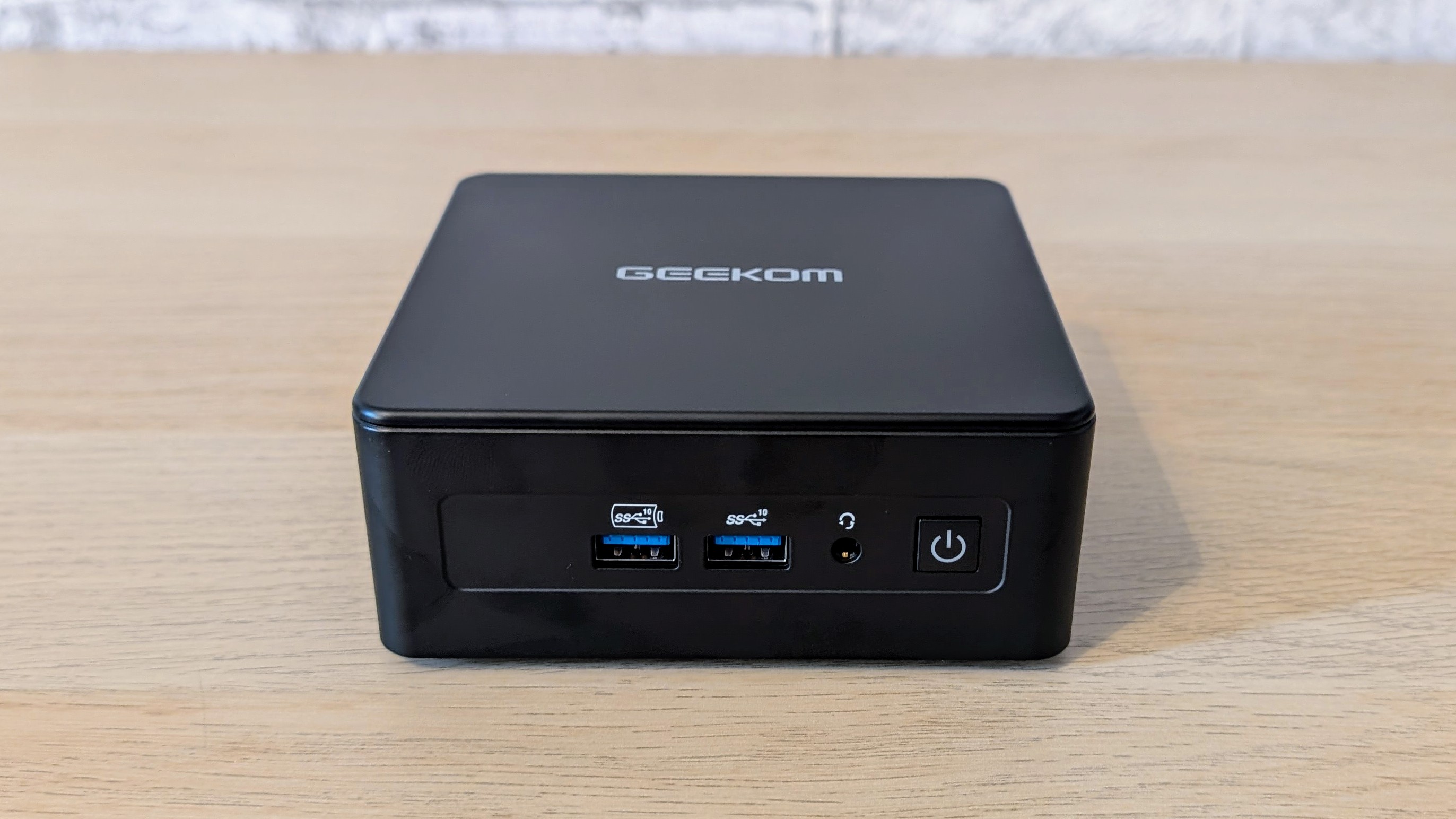
Given the pretty hefty price, you'd expect a high level of build quality, and Geekmon has certainly delivered here. The whole unit is made from stiff metal sheeting and feels very solid and robust. The matte-finish black paint job lends the unit an impressive degree of understated elegance.
Given that it's built around such a powerful processor, the IT15 is a very petite device measuring up at just 117 x 112 x 45.5mm and weighing a piffling 560g. This makes it an ideal candidate to be hidden away behind a monitor, and indeed Geekom bundles a VESA bracket and screws for just this use.
Given the Liliputian dimensions, the designers have done a good job of shoehorning in a wide range of I/O ports. On the front panel next to the power button, you'll find a 3.5mm audio jack and two 10Gbps USB-A ports.
On the rear panel, there are two 40Gbps USB-C ports, both supporting DisplayPort video, as well as a 2.5GbE RJ-45 jack, 10Gbps and 480Mbps USB-A ports, two HDMI 2.1 video outputs, and the DC-in jack.
Sign up today and you will receive a free copy of our Future Focus 2025 report - the leading guidance on AI, cybersecurity and other IT challenges as per 700+ senior executives
One of the USB-C ports also supports Power Delivery, which is useful if you want to leave the unusually small and light 120W power brick at home and use a phone-friendly Type-C power supply. The 100W USB-C charger I had to hand powered the IT15 perfectly. Rounding things out, there's an SD 4.0 memory card slot on the left side and a Kensington lock on the right.
Our only comment on the ports is that, given the price and the target market, we'd have preferred to see a standard DisplayPort video output, even if that was in place of one of the HDMI ports.
As you'd expect, getting inside the Geekom IT15 AI is a very easy operation. Just slacken off the four Philips screws that sit inside the rubber feet at each corner, and the base plate comes away cleanly.
Once in, there is very easy access to the two SODIMM mounts and the two SSD emplacements, one for an M.2 PCIe 4 2280 drive, the other for a SATA 3 2242 drive. Welded to the inside of the base plate is a bracket for a 2.5in HDD, though Geekom doesn't bundle any of the cables to connect said to the motherboard or the HDD LED power supply.
The Wi-Fi card is buried deeper inside the assembly, but given that it's a bang-up-to-date Intel BE200 unit that supports Wi-Fi 7 and Bluetooth 5.4, it's an unlikely candidate for replacement.
Geekom IT15 AI: Specs and Performance
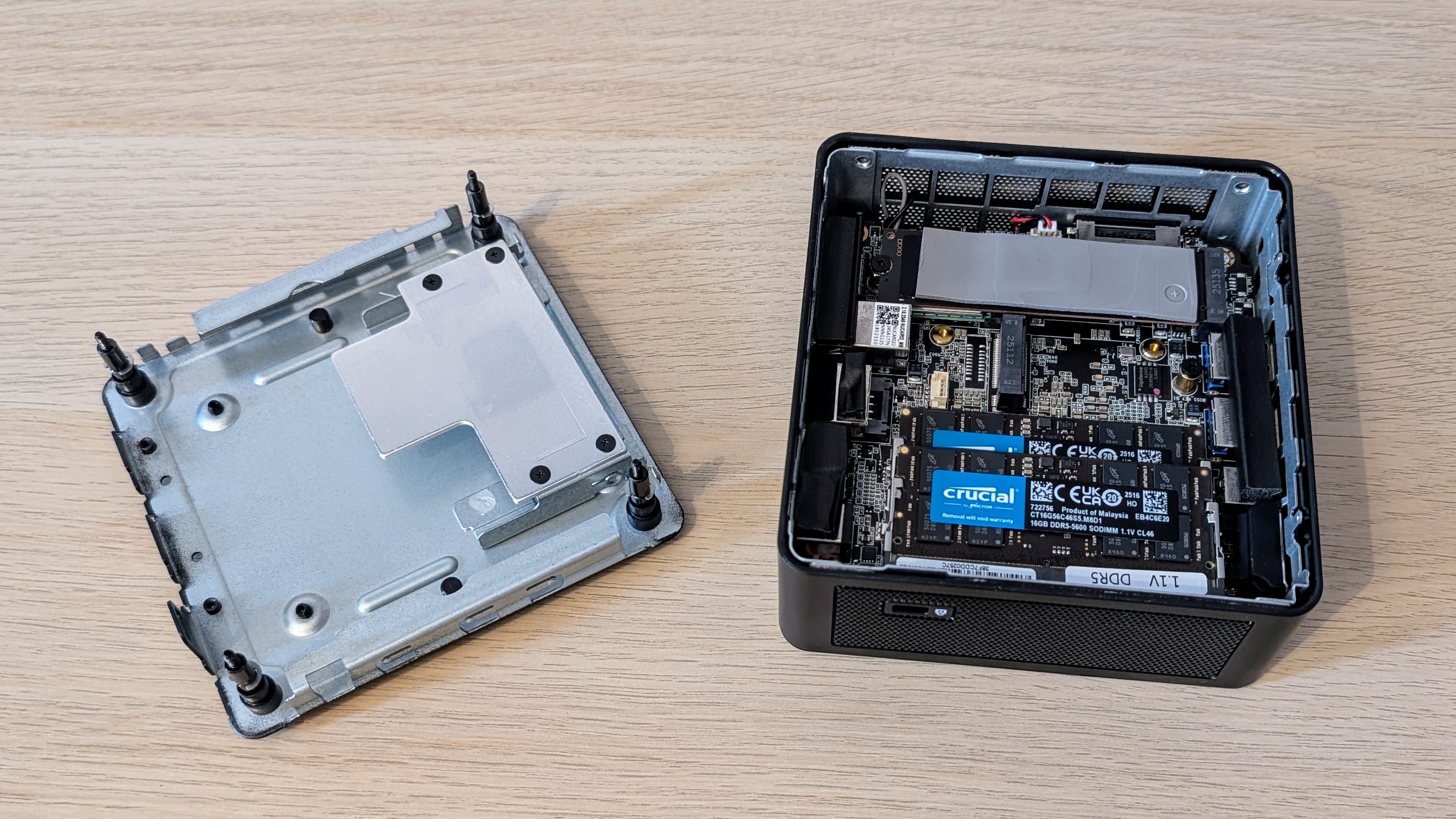
The CPU inside the Geekmon IT15 AI is an Intel Arrow Lake Core Ultra 9 285H with 16 cores, of which 6 are rated Performance, a maximum turbo frequency of 5.4GHz, and a 65W TDP. That combines with 32GB of 5600MHz DDR5 RAM to deliver a very useful level of performance.
Indeed, the chipset is considerably more potent than the Meteor Lake Core i9-13900HK-based competition used in the likes of the Beelink SEi13 and Geekom Mini IT13, as demonstrated by its impressive score of 361 in our 4K multimedia benchmark. For comparison, the Beelink SEi13 scored 272 and the Geekom Mini IT13, 262.
The new Geekmon box also performed well in the PCMark 10 benchmark, scoring 7,450 points, comfortably ahead of the 4,945 scored by its junior sibling, the Ryzen 5-powered Geekmon A5, or the 6,066 scored by the Lenovo ThinkCentre M70q Gen 4 Tiny, which runs on an Intel Core i7-13700T CPU.
When it comes to plain CPU performance, the difference is less marked but still clear: In the Cinebench R23 multi-core test, the IT15 scored 15,524 points, compared to the Beelink box's 14,199, Lenovo's 12,914, and the Geekom Mini IT13's 12,127.
Turning to graphics performance, the new Geekom box shows the Meteor Lake competition a very clean pair of heels, running the SPECviewperf 3dsmax 3D modelling benchmark at an impressive 29fps, twice as fast as the Irix Xe iGPU that comes as part of Intel's Meteor Lake chipsets.
If you want a mini PC for any sort of graphics work, but can't stretch to a box with a discrete GPU, the IT15 is certainly worth considering.
The one drawback with an Arrow Lake CPU is that the associated NPU is far less powerful than the one you get with a Lunar Lake chip, rated at only 13 TOPS rather than 48. This means that despite the 285H being a new CPU, you'll miss out on certain of Microsoft's Copilot+ features like Recall, which takes regular snapshots of your on-screen activity for later reference.
Of course, given the security and privacy concerns that accompanied the initial announcement of Recall and the subsequent changes made before its eventual rollout by Microsoft, the absence of this feature may not be regarded as an altogether bad thing by many commercial users.
The Geekom's single cooling fan goes about its business quietly and without drama, but isn't quite up to the job of keeping the CPU fully cooled when running hard for prolonged amounts of time. Under heavy stress, the core temperature quickly peaked at 90 degrees, which cut the CPU utilisation to just 40 per cent.
After around five minutes, the CPU and the cooling system reached a mutual understanding, and utilisation jumped back to around 60%, where it remained for the duration of the stress test. This is hardly a deal-breaking problem, but it does just take the edge off the CPU's theoretical maximum performance level.
Our review unit came fitted with a 2TB Crucial SSD, which proved to be an impressive performer, returning sequential read and write speeds of 5,211MB/s and 4,409MB/s, respectively.
The Geekom IT15 comes loaded with Windows 11 Pro, and there's no option to buy without an operating system. As is our want, we booted it up into Ubuntu 24.10 and found that everything worked as it should.
Geekom IT15 AI: Is it worth it?
The Geekom IT15 is one of the more expensive mini PCs that we've tested, be it from a niche Chinese OEM or a more established manufacturer like Asus or Lenovo. That said, it's also one of the most powerful and one of the smallest mini PCs we've tested. Indeed, it's a little bigger than the likes of the budget N150-powered Acemagic Vista V1.
Granted, Geekom's efforts to squeeze a full pint of PC into a half-pint container may have slightly compromised the cooling system under extremis, but there's no arguing with the impressive achievement of fitting such a potent chipset as well as a wide range of I/O ports, three internal storage bays and a brace of SODIMM modules into such a wee machine.
Given all that, plus the fact you get a brace of USB-C 4.0 ports, the very latest wireless communication standards, a 2TB SSD, and 32GB of RAM for your money, it's difficult not to conclude that the Geekom IT15 represents solid value for money when placed alongside the Meteor Lake alternatives.
Geekom IT15 AI Specs
Processor | Intel Core Ultra 9-285H | Row 0 - Cell 2 |
GPU | Intel Arc 140T GPU | Row 1 - Cell 2 |
RAM | 32GB DDR5-5600 | Row 2 - Cell 2 |
Ports | USB-C 4.0 x 2, USB-A 3.2 Gen 2 x 3, USB-A 2.0 x 1, HDMI 2.1 x 2, 2.5GbE RJ-45 x 1, 3.5mm audio x 2, SD Card 4.0 x 1 | Row 3 - Cell 2 |
Storage | 2TB M.2 2280 PCIe Gen 4, mount for a second M.2 2242 SATA 3 SSD or a 2.5in SATA 3 HDD | Row 4 - Cell 2 |
Connectivity | Wi-Fi 7, Bluetooth 5.4 | Row 5 - Cell 2 |
Weight | 560g | Row 6 - Cell 2 |
Dimensions | 117 x 112 x 45.5mm | Row 7 - Cell 2 |
OS | Windows 11 Pro | Row 8 - Cell 2 |
Over the years, Alun has written freelance for several online publications on subjects ranging from mobile phones to digital audio equipment and PCs and from electric cars to industrial heritage. Before becoming a technology writer, he worked at Sony Music for 15 years. Quite what either occupation has to do with the degree in Early Medieval History he read at the University of Leeds is a bit of a grey area. A native of Scotland but an adopted Mancunian, Alun divides his time between writing, listening to live music, dreaming of the glens and dealing with an unhinged Norwegian Elkhound. For ITPro, Alun reviews laptops and PCs from brands such as Acer, Asus, Lenovo, Dell and HP.
-
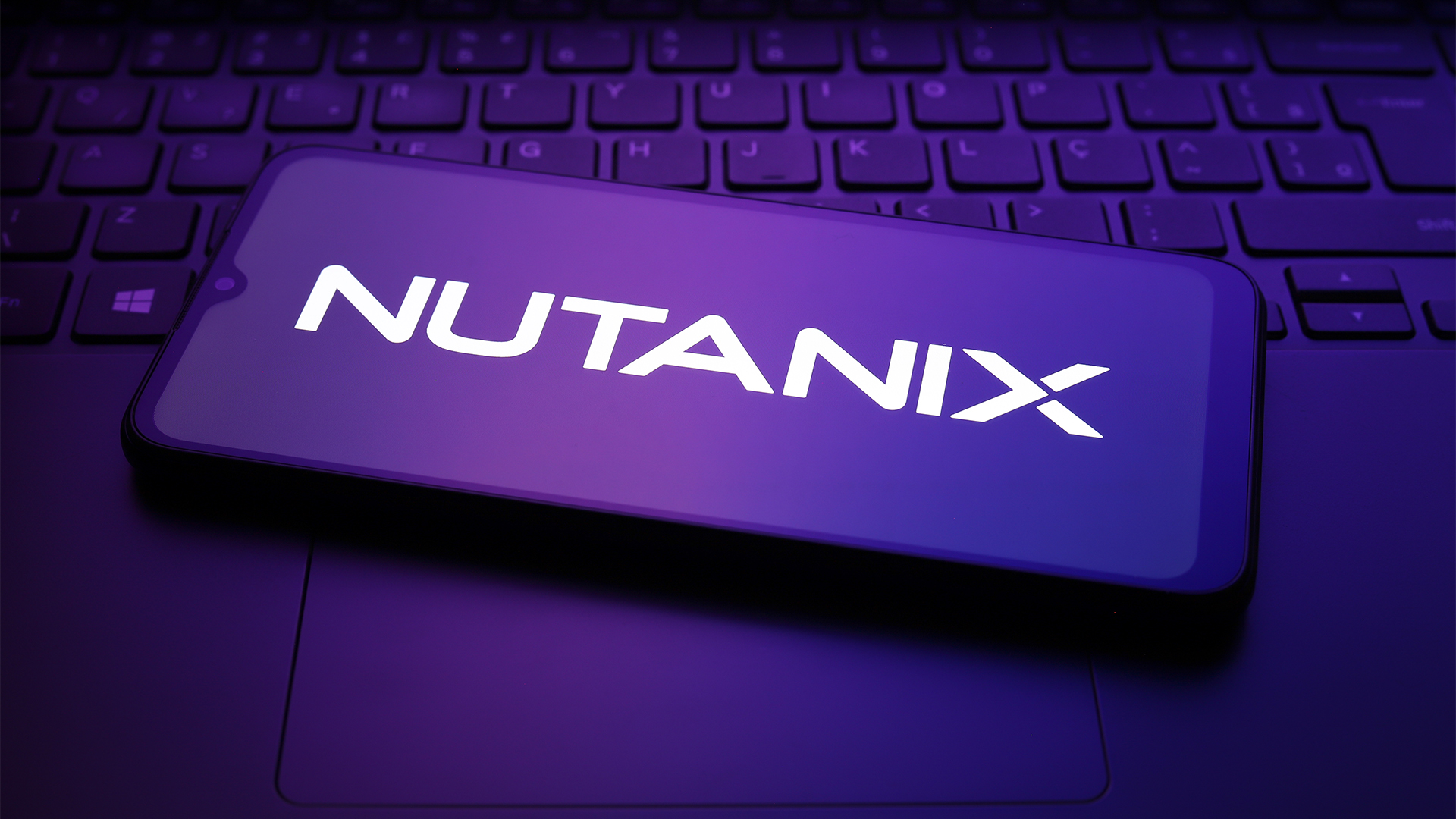 Nutanix wants to help customers shore up cloud sovereignty
Nutanix wants to help customers shore up cloud sovereigntyNews New automation tools and infrastructure management capabilities look to tackle single-vendor dependency and shore up sovereignty requirements
By Ross Kelly Published
-
 The NCSC touts honeypots and ‘cyber deception’ tactics as the key to combating hackers — but they could ‘lead to a false sense of security’
The NCSC touts honeypots and ‘cyber deception’ tactics as the key to combating hackers — but they could ‘lead to a false sense of security’News Trials to test the real-world effectiveness of cyber deception solutions have produced positive results so far
By Emma Woollacott Published
-
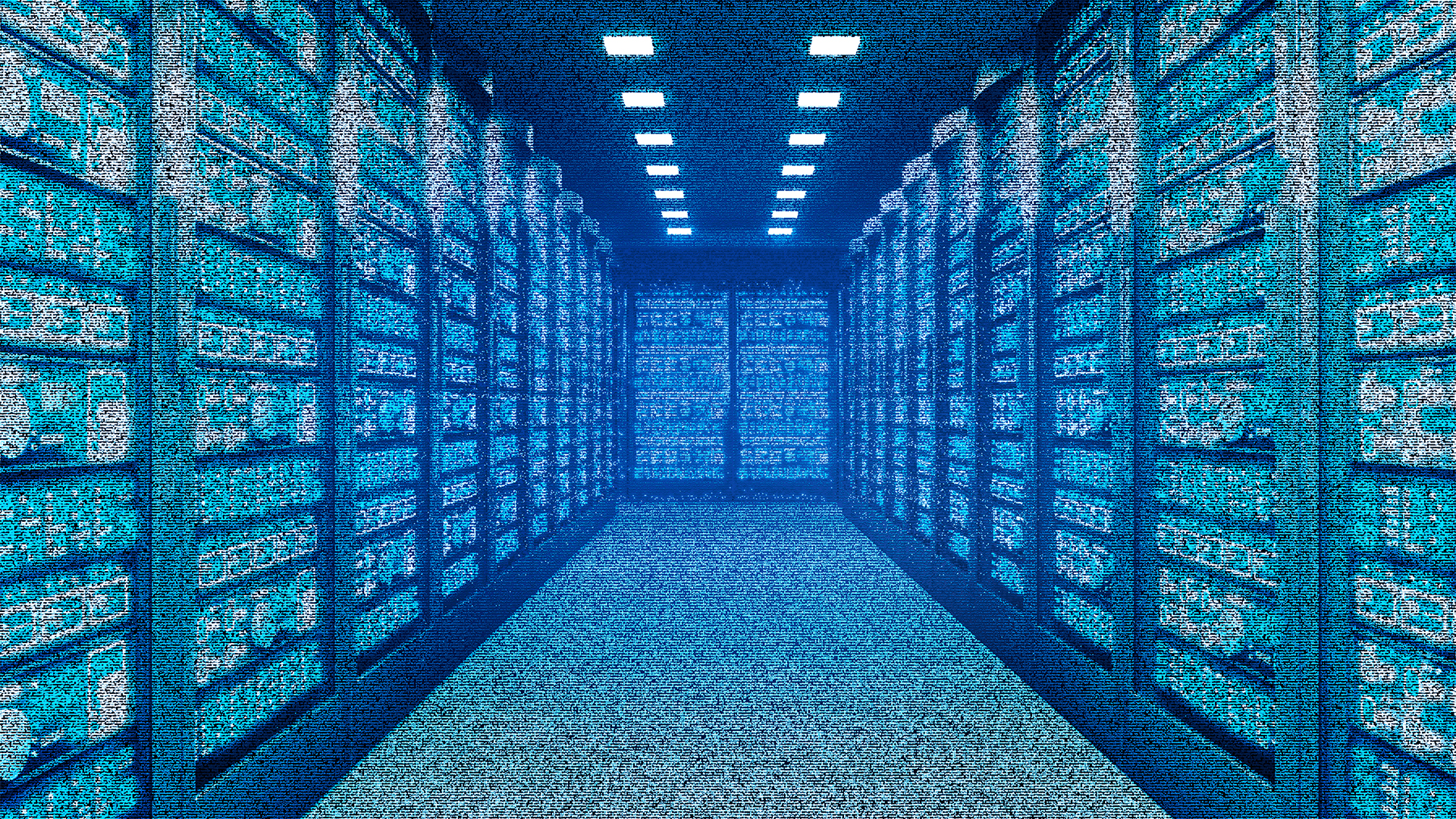 Can data center supply keep up with AI demand?
Can data center supply keep up with AI demand?News New research from Goldman Sachs points to a precarious balancing act for data center operators
By Emma Woollacott Published
